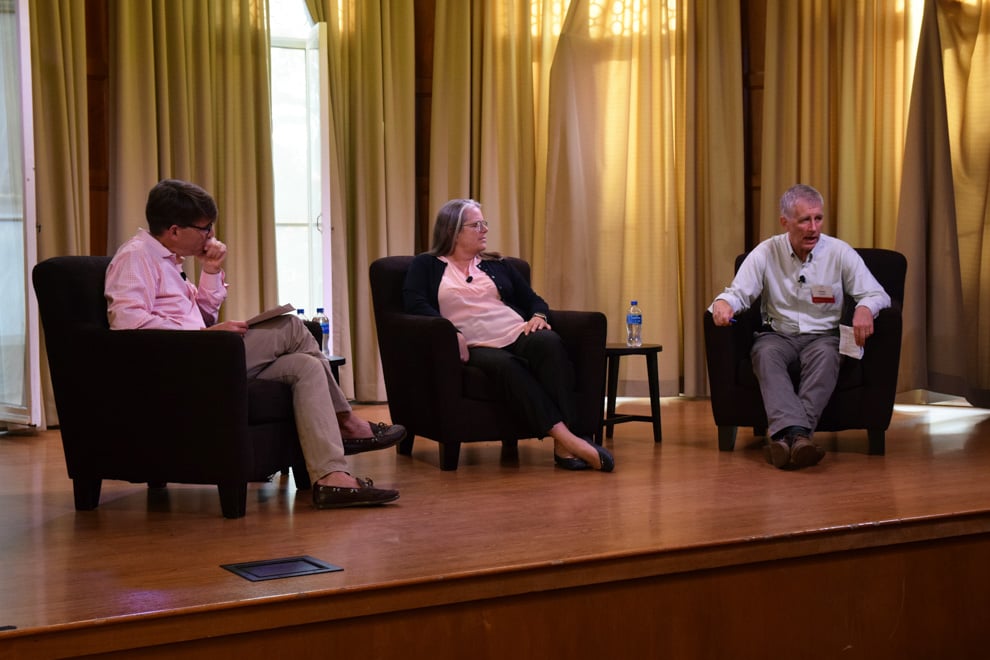On Thursday, the Stanford Historical Society and Roble resident fellows Jeffrey Ball and Becky Bull hosted a discussion on Roble’s history of equality and diversity, to celebrate the dorm’s centennial anniversary.
The event featured U.S. history professor James T. Campbell and director of Heritage Services Laura Jones as speakers. Ball kicked off the discussion with a reflection on what he referred to as Roble’s long and complex history.
“Roble’s history has been messy and rich,” Ball said. “It’s been politically fraught. It has been seismically interesting … It has been socially groundbreaking.”
Ball commended Roble for being the closest representation of the diversity of the world on campus.
“[Roble] is maybe the most diverse place on the Stanford campus,” Ball said. “This is, I think it’s fair to say, the closest undergraduate residence that Stanford has to the world.”
Campbell discussed how residential education within a university can allow students to learn from diverse communities on campus – lessons they might not have learned in the classroom.
“Most of what we aspire to produce in a Stanford student – qualities of reflectiveness, tolerance, the ability to function comfortably in diverse environments, leadership and also the ability to be led – are things that actually students are modeling learning about more, in some fashion, in their residences than when they pass through a classroom,” Campbell said.
He also highlighted Roble’s sustainability efforts, referencing the Roble Living Laboratory for Sustainability at Stanford.
“Students are not just sitting in some classroom where they are taking a course on sustainable product design … they’re actually understanding, [in] really intimate ways, ways in which sustainability is something that actually happens, not in the classroom, but in real life,” Campbell said.
Jones, who is also the University archaeologist, gave insight into her discoveries from researching Roble Hall in The Daily archives. Citing the Greek pledge system, Jones explained how the egalitarian community in Roble sharply contrasts to those seen in Greek life.
In the 1970s, Roble set aside space for African American, Latinx and Native American students who wanted to live together, which later led to the formation of ethnic-themed dorms such as Ujamaa.
“The first self-selected concentration of African-American students in residence happened here [at Roble] as a micro-community,” Jones said.
According to her, Roble was established as an all-women’s dorm in 1918, inviting women who didn’t want to join sororities and didn’t agree with the exclusivity of those residences to join a more accepting community.
“Roble women object to this – the notion that there were winners and losers and that you got selected because your mother was in a sorority,” Jones said. “You weren’t being judged on your merits. So, they had what was called a Roble Revolt.”
Jones explained how women who lived in Roble during its early years helped foster a community that was distinctly different from the rest of the University.
“The Roble Hall women held the campus to a higher standard,” Jones said.
She added that Roble, with its abundance of social spaces, became the center of an egalitarian community that other dorms later adopted, based off a notion from Jane Stanford herself.
“Jane Stanford was particularly concerned about elitism,” Jones said. “She was particularly concerned about privilege and about any kind of social class distinctions among students.
At the end of the discussion, the floor opened to Roble alumni, who shared stories of their experiences in the dorm, ranging from earthquakes to students’ responses to major events in history, such as the AIDS crisis. Throughout the stories, there was a common thread: love for the dorm and its intricate past.
Contact Antonio Rios at antorios ‘at’ stanford.edu.
